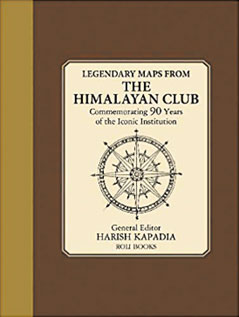Legendary Maps of the Himalayan Club (by Venables)
LEGENDARY MAPS FROM THE HIMALAYAN CLUB. General Editor Harish Kapadia (with M.H. Contractor and Smruthi Ranganathan). Pp. 240. B/W photos and Maps. (Roli Books, New Delhi, 2018, Rs. 1500/-)

Maps, to misquote Shakespeare, are such stuff as dreams are made on. Staring at the glitzy computer generated 3D realization of a Google Earth satellite photo is all very well, but you can’t beat the magic and mystery of an old fashioned pen and ink map.
During my early days of Himalayan expeditioning I used to spend hours poring over orographic sketchmaps, with their bold black ridgelines, dotted glacier boundaries and snaking rivers, dreaming, plotting and wondering – wondering what those valleys actually looked like when you got there, wondering where you might cross those rivers, wondering just how accurate the maps actually were. Even thirty years ago, when satellite photos were not generally available, these simple sketches were still the raw material for our exploratory adventures.
Back in 1928, when The Himalayan Club was founded, there were, for large tracts of the Himalayan and Karakoram, no maps at all. Even in 1950 the French had first to find Annapurna before they could climb it. And, Google Earth notwithstanding, much of the finer detail is still undiscovered – Himalayan climbing remains essentially a process of exploration. Who better to celebrate that ongoing journey of exploration than Harish Kapadia, leader of countless expeditions from Himachal Pradesh to Arunachal Pradesh, and for many years editor of The Himalayan Journal, assisted here, by Muslim Contractor and Smruthi Ranganathan.
The book is unashamedly nostalgic, printed on delicately mottled paper, with monochrome photos in a warm sepia tint. The maps and mountain sketches are accompanied either by the editors’ commentaries or by original articles from the Journal. Legendary names include Bill Tilman, Trevor Braham, André Roch and Kapadia himself. Sketches include Bob Downes’ evocative pen and ink rendering of the 1957 oh-so-near but doomed attempt on Masherbrum and Martin Moran’s detailed drawing of Nilkanth’s West Ridge, climbed for the first time in 1980. For me the real gem is a double page spread pictorial representation of the Nanda Devi Sanctuary by D. Macpherson. Surely I must have seen it before? But I can’t recall this 1930s answer to Google Earth – a beautifully graphic 3D representation of the great cirque of Garhwal peaks, with its evocatively title ‘Inner Wall’ and the routes of early probes all traced in dotted lines, culminating in Shipton’s and Tilman’s triumphant 1935 expedition with Ang Tharkay & Co. And so to the photos. I must confess some personal nostalgia here. It’s good to see old friends and acquaintances such as Soli Mehta, Muslim Contractor, Paul Nunn, the ancient lama in Chitkul who died recently at the age of 103 and the incomparable gleaming smile of Harsinh Harkotia, cheerfully carrying a monstrous load across the flooded Terong River during our 1985 exploration of the Rimo massif.
More to the point, it is good to see some rare gems such as the boat found in 1949 beside the former Chong Kumdan lake in the upper Shyok valley or an early example of explorers’ graffiti inscribed on a Siachen rock by Professor Dainelli’s expedition in 1930. There is a lovely shot of Shipton and Ang Tharkay in the Karakoram and a fine group photo of that doyen of explorers, Gordon Osmaston, with his Garwhal survey team. Most startling is the period gothic script of a certificate presented by Adolf Hitler to surviving Sherpas of the 1934 Nanga Parbat expedition. A great journal, like the Himalayan Journal, is fifty percent scientific and historical record and fifty percent entertainment and inspiration. This anniversary selection is a wonderful celebration of that success. Let us drink to the next ninety years.
STEPHEN VENABLES
